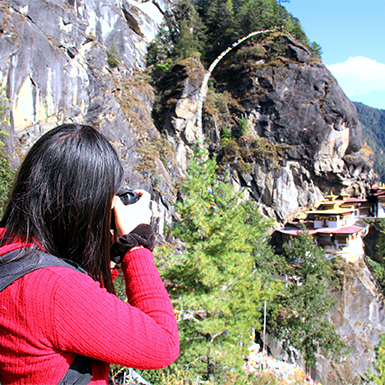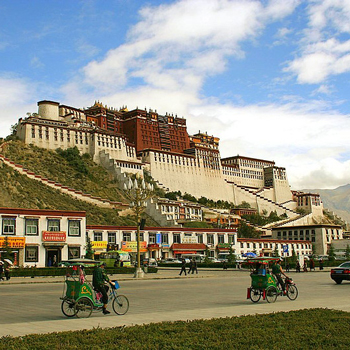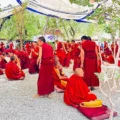Few figures shine as brightly in the annals of history as Princess Wencheng. More than a political union, Wencheng’s marriage to Tibetan King Songtsen Gampo in the 7th century sparked a vibrant cultural exchange between the Tang Dynasty and the Tibetan Empire.
A Pioneer of Progress
Princess Wencheng’s arrival in Tibet sparked a wave of innovation and advancement. She actively championed new ideas and practices, forever changing the course of Tibetan history:
- Agricultural Revolution: Wencheng introduced advanced farming techniques and diverse crops, revolutionizing agriculture and significantly improving the Tibetan people’s quality of life.
- Artistic Flourishing: Skilled artisans accompanying Gyasa shared their mastery of weaving, pottery, and metalwork, infusing Tibetan artistic traditions with new perspectives and techniques.
- Medical Breakthroughs: Wencheng’s expertise in Chinese medicine led to the founding of Tibet’s first medical college, ushering in a new era of healthcare for the region.
- Spiritual Enlightenment: As a devout Buddhist, Wencheng actively promoted and established Buddhism in Tibet, overseeing the construction of iconic temples like the Jokhang Temple in Lhasa, which remains a spiritual heartland for Tibetan Buddhists today.
- Literacy and Learning: People celebrate Wencheng for introducing a written script for the Tibetan language derived from the Indian Devanagari script. This groundbreaking contribution paved the way for the development of Tibetan literature and scholarship.
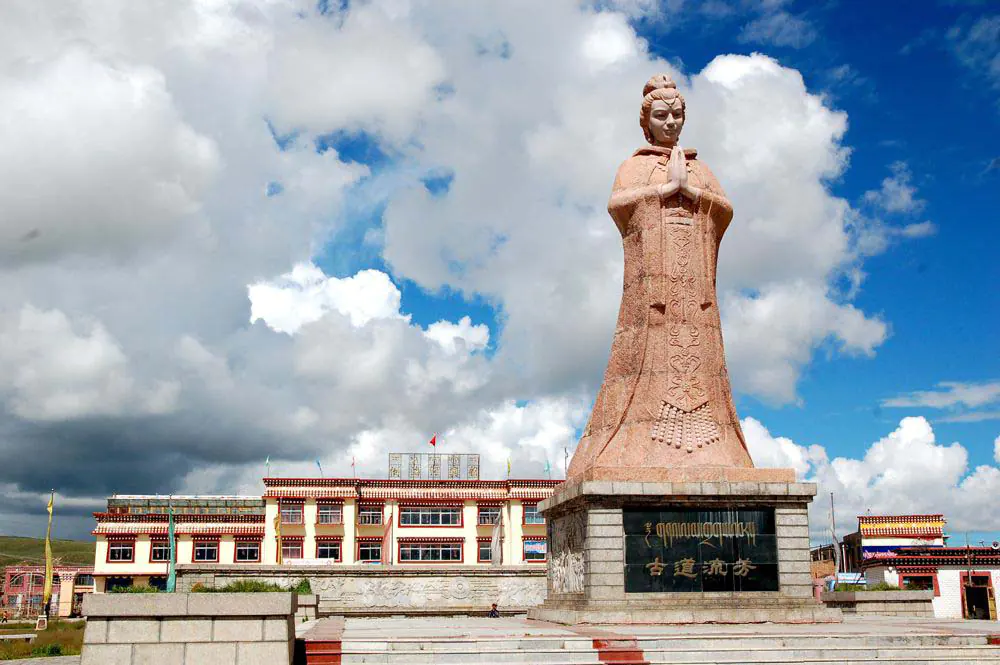
An Enduring Legacy
The ripple effects of Wencheng’s initiatives continue to shape Tibetan culture today.
- Spiritual Transformation: Her introduction of Buddhism sparked a spiritual revolution, giving rise to the unique and vibrant form of Tibetan Buddhism that flourishes today.
- Economic Prosperity: The agricultural innovations she introduced play a vital role in the Tibetan economy, especially in regions where people still practice traditional farming methods.
- Cultural Enrichment: The artistic and technological knowledge she shared continues to inspire and influence Tibetan artisans and craftspeople.
Preserving Princess Wencheng’s Memory
Throughout Tibet, various sites stand as testaments to Princess Wencheng’s enduring legacy:
- Jokhang Temple: This sacred temple houses a revered statue of Jowo Shakyamuni Buddha, believed to have been brought by Wencheng from China.
- Ramoche Temple: Built under Wencheng’s watchful eye, this temple remains an important religious and historical landmark.
- Tradruk Temple: The temple’s walls display a precious thangka (Tibetan Buddhist painting) that Gyasa created.
From Tang Princess to Tibetan Queen – A Life of Purpose and Influence
The story of Princess Wencheng weaves through the tapestry of Tibetan history. A Tang Dynasty princess who married into Tibetan royalty, she became a bridge between cultures and ignited transformative change. Her trip began in the heart of the Tang Dynasty, where a wealthy upbringing prepared her for an extraordinary destiny.
A Princess of the Tang Dynasty
Born into the prestigious Li family during Emperor Taizong’s reign, Wencheng, likely called Li Daozong, was a revered military general and the emperor’s cousin, her father. While the specifics of her early years remain mysterious, historical accounts portray a young woman raised in the intellectual and artistic fervor of the Tang court. This environment undoubtedly molded her character and shaped her worldview.
Nurtured in the Imperial Court: Education and Upbringing
As a Tang Dynasty princess, Wencheng received an education befitting her royal lineage. It likely included:
- Confucian Classics: The study of foundational Chinese philosophy texts, such as the Confucian Classics, instilled in Princess Wencheng a deep sense of ethics, morality, and social responsibility—values she would carry with her to Tibet and integrate into her role as queen, fostering a harmonious relationship between the two cultures.
- Literature and Poetry: The Tang Dynasty’s flourishing literary scene exposed Wencheng to the works of renowned poets and scholars, nurturing her appreciation for artistic expression and laying the groundwork for her future role as a patron of the arts in Tibet.
- Arts and Music: The Tang Court, a vibrant center of artistic innovation, provided Wencheng access to a wealth of musical, dance, and visual art forms, enriching her cultural understanding and fostering a love for creativity.
- Buddhism: A devout Buddhist, Gyasa engaged deeply with Buddhist teachings from a young age. These teachings instilled in her profound spiritual beliefs and values that would guide her actions and influence her interactions with the Tibetan people.
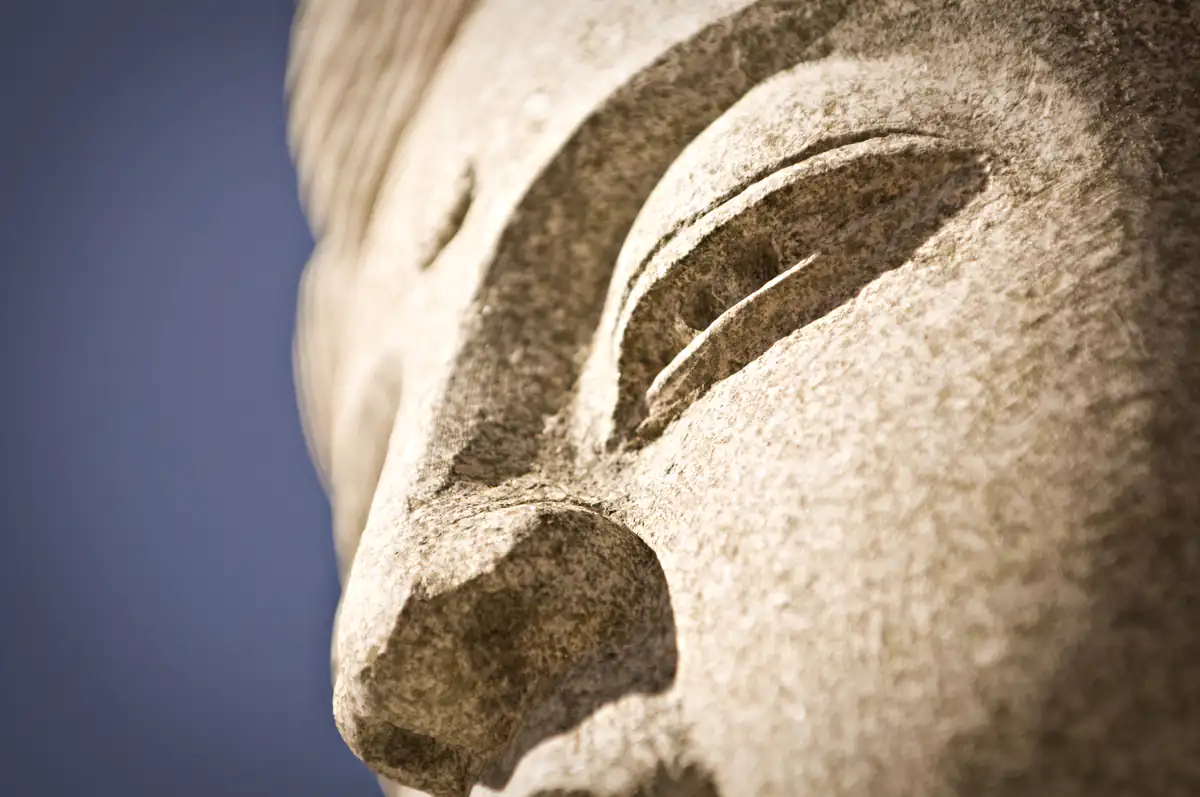
A Woman of Grace, Intelligence, and Compassion
Historical records may be sparse, but they reveal glimpses of Princess Wencheng’s character: a woman of intelligence, grace, and deep compassion. These qualities, nurtured in the Tang court, would prove indispensable as she navigated the complexities of her role as a Tibetan queen and cultural ambassador. Her ability to connect with people from all walks of life would foster understanding and cooperation between the Tang and Tibetan empires.
A Marriage that Forged a New Path
The Tang Dynasty chose Wencheng to marry Songtsen Gampo, the king of Tibet, marking a dramatic turn in her life. This marriage, while a political alliance, was also a testament to Wencheng’s exceptional character and potential to bridge cultural divides. Her tour to Tibet began a new chapter filled with challenges, triumphs, and a lasting legacy.
A Princess, a Pact, and a Legacy: Princess Wencheng’s Marriage to Songtsen Gampo
The 7th century was a time of power struggles in Asia. The mighty Tang Dynasty ruled China, while the Tibetan Empire rapidly expanded its influence. Frequent skirmishes threatened regional stability. But then, a remarkable event – the marriage of Princess Wencheng to King Songtsen Gampo of Tibet – changed the course of history.
From Rivalry to Alliance: A Daring Proposal
Imagine a world map where China and Tibet are continuously vying for dominance. That was the reality in the early 7th century. King Songtsen Gampo, a visionary Tibetan leader, recognized the need for peace and a more stable future. His audacious proposal was a marriage alliance with the Tang emperor. It wasn’t just about finding a bride for the king; it was a strategic move to forge a lasting bond between the two empires.
The Significance of a Royal Union
Marrying Princess Wencheng from the Tang Dynasty offered a win-win situation for both sides:
- Peace and Prosperity: A formal alliance would deter future conflicts, allow trade routes to flourish, and benefit both economies.
- Open Communication Channels: Establishing diplomatic channels would facilitate trade agreements and cultural exchange, fostering mutual understanding.
- Bridging the Gap: Marriage could act as a bridge between the two cultures, leading to a rich exchange of ideas, art, and customs.
East Meets West on the Silk Road
In 634 AD, Emperor Taizong of Tang agreed to the proposal. Gyasa, a member of a minor royal branch, was chosen as the bride. But her tour wasn’t a stroll down the street. It was a long and arduous trek along the Silk Road, the famous trade route connecting China and the West.
- The Challenges of the Journey: The distance between Chang’an (present-day Xi’an), the Tang capital, and Lhasa, the Tibetan capital, was vast, spanning thousands of miles. The treacherous mountain passes, unforgiving terrain, and harsh weather conditions posed a significant challenge for Princess Wencheng and her entourage.
- A World Apart: Beyond the physical challenges, Wencheng had to adapt to a new way of life. The food, customs, language, and even the high altitude of the Tibetan Plateau were different from everything she knew.
Cultural Trailblazer and Tibetan Transformation
Princess Wencheng’s impact on Tibet extended far beyond her role as a royal bride. She was a cultural trailblazer who enriched Tibetan society with knowledge, skills, and traditions from the Tang Dynasty. Today, her legacy influences Tibetan agriculture, art, architecture, fashion, and cuisine.
Gifts from the Tang Dynasty: Wencheng’s Transformative Contributions
Princess Wencheng arrived in Tibet not only as a bride but as a cultural ambassador. She brought with her skilled artisans and scholars, each eager to share their expertise with the Tibetan people.
- Agricultural Innovation: Wencheng introduced advanced farming techniques to the Tibetan plateau, including new crops like barley and wheat and innovative irrigation methods. This knowledge revolutionized Tibetan agriculture, leading to increased crop yields and improved livelihoods for the people.
- Artistic Inspiration: The artisans who accompanied Gyasa shared their mastery of weaving, pottery, and metalwork, introducing new techniques and materials. Tibetan craftspeople eagerly embraced these innovations, leading to a flourishing artistic scene and the development of distinctive Tibetan styles in textiles, ceramics, and metal crafts.
- Healing Traditions: Wencheng’s knowledge of Chinese medicine proved invaluable to the Tibetan people. She founded Tibet’s first medical college, where she taught herbal remedies and acupuncture techniques. This exchange of medical knowledge enhanced healthcare in the region and fostered the evolution of Tibetan medicine.
- Architectural Marvels: Princess Wencheng’s influence on Tibet reached beyond cultural practices, leaving a lasting impact on the region’s architectural landscape, as seen in iconic structures like the Jokhang Temple. She oversaw the construction of several iconic structures, most notably the Jokhang Temple in Lhasa. This masterpiece of Tibetan architecture, a UNESCO World Heritage site, remains a spiritual center for Tibetan Buddhists. The temple’s design seamlessly blends Chinese and Tibetan elements, a testament to Wencheng’s ability to harmonize diverse cultural influences.
- Everyday Elegance: Wencheng’s impact reached the everyday lives of Tibetans. She introduced new styles of clothing, including silk garments and intricate headdresses. The Tibetans embraced these fashions, incorporating them into their traditional attire. Similarly, Wencheng brought new culinary traditions from the Tang Dynasty, enriching Tibetan cuisine with diverse flavors and ingredients.
A Bridge Between Cultures and Faiths
Princess Wencheng’s wedding to King Songtsen Gampo of Tibet in the 7th century was not merely a royal marriage. It is a narrative of mutual cultural enrichment and political policy, the transformational impact of Wencheng on the penetration of Buddhism in Tibet.
A Devout Princess on a Mission
Historical accounts portray Gyasa as a dedicated Buddhist. She reportedly brought Buddhist statues and sutras (sacred texts) on the arduous tour to Lhasa. It wasn’t just for personal comfort but a deliberate act to introduce Buddhism to her new homeland.
Beyond Personal Devotion: Promoting Buddhism in Tibet
Princess Wencheng’s role went beyond simply bringing religious artifacts. Here’s how she actively promoted Buddhism:
- Temple Construction (Possible Link): While historical evidence isn’t conclusive, some sources credit Princess Wencheng for establishing the Ramoche Temple in Lhasa. Today, it’s a significant pilgrimage site for Tibetan Buddhists.
- Artistic Influence: Skilled artisans likely accompanied Wencheng. Their presence may have introduced Buddhist iconography and creative styles to Tibet, enriching the region’s artistic traditions.
A Faith Takes Root: Buddhism’s Impact on Tibetan Society
Princess Wencheng’s efforts, along with those of the Nepalese princess who also married Songtsen Gampo, helped plant the seeds of Buddhism in Tibet. Over time, Buddhism flourished, becoming a central pillar of Tibetan culture and society:
- Social Transformation: Buddhist teachings on compassion, non-violence, and karma profoundly influenced Tibetan social values and ethical codes.
- Monastic Orders Emerge: The rise of Buddhism led to the establishment of numerous monasteries throughout Tibet. These institutions became centers of learning, religious practice, and social life.
- Artistic Flourishing: Tibetan art embraced Buddhist themes. Sculptures, paintings, mandalas, and intricate diagrams representing the cosmos became prominent artistic expressions.
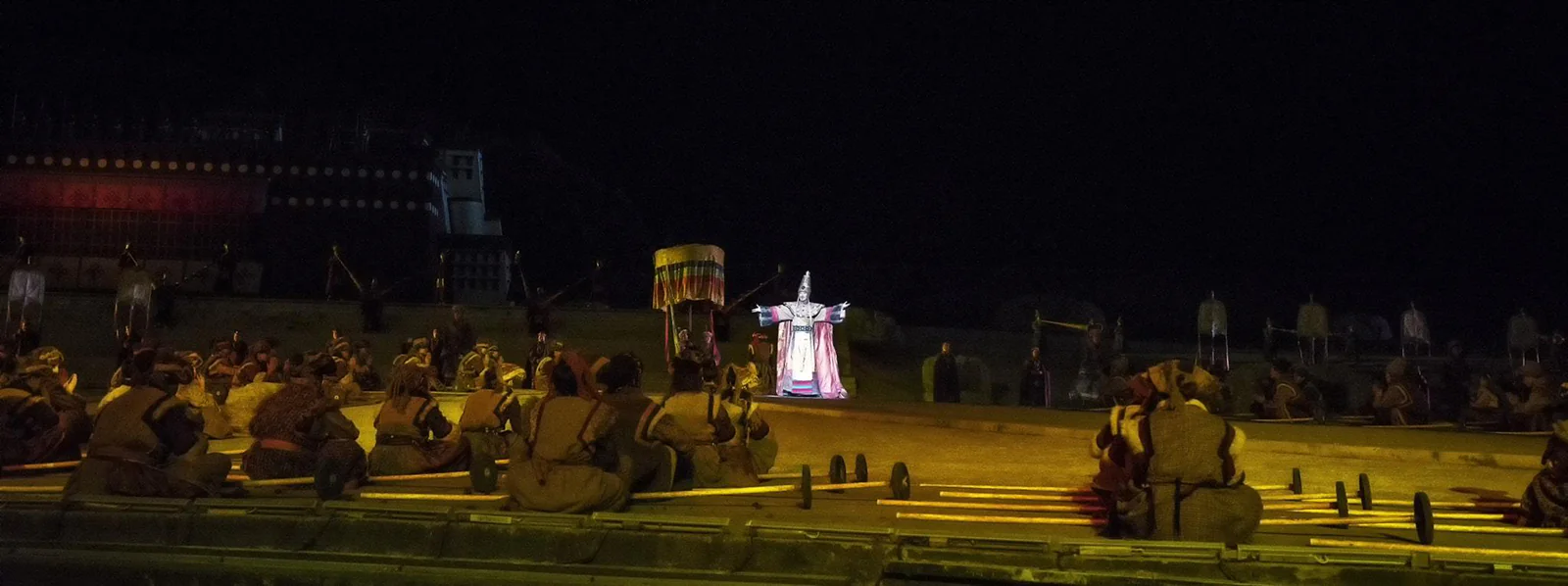
Princess Wencheng’s Enduring Legacy: A Symbol of Unity and Cultural Enrichment
The impact of Princess Wencheng’s arrival in Tibet during the 7th century continues to echo through the ages. She left an enduring legacy of peace, cultural exchange, and transformative progress. Her story continues to inspire, and the Tibetan people deeply cherish her memory.
The Unwavering Influence of Princess Wencheng
Wencheng’s contributions to Tibet reached far beyond her role as a royal consort. She catalyzed advancement, leaving an enduring legacy that shaped the region’s destiny.
- A Unifying Force: Princess Wencheng’s marriage to King Songtsen Gampo fostered a lasting peace between the Tang Dynasty and the Tibetan Empire. Her skillful diplomacy and cultural sensitivity bridged the gap between two distinct cultures, promoting understanding and cooperation. This alliance laid the foundation for centuries of peaceful relations and fruitful cultural exchange.
- Champion of the Arts: Wencheng’s passion for art and culture ignited a creative renaissance in Tibet. The artisans she brought from the Tang Dynasty shared their skills and knowledge, enriching and elevating Tibetan artistic traditions. Her influence shines through in the vibrant thangka paintings, intricate sculptures, and ornate architecture throughout the region.
- Spiritual Luminary: Wencheng’s unwavering devotion to Buddhism was pivotal in establishing it as the dominant religion in Tibet. Her efforts to build temples and monasteries, including the iconic Jokhang Temple in Lhasa, created sacred spaces for spiritual practice and learning. Buddhism became deeply intertwined with Tibetan culture, shaping its values, traditions, and worldview.
A Revered Figure in Tibetan Folklore and Art
The captivating story of Gyasa has been passed down through generations and immortalized in Tibetan folklore and art. She often appears as a compassionate figure, a symbol of unity, and a bridge-builder between cultures.
- Folklore: Tibetan folktales celebrate Wencheng as a wise and benevolent queen who brought blessings to the land. Her stories emphasize her kindness, generosity, and unwavering dedication to the well-being of her people.
- Artistic Inspiration: Wencheng is a recurring figure in Tibetan art, appearing in thangkas (painted or embroidered scrolls), murals, and sculptures. Artists often depict her alongside Songtsen Gampo, symbolizing the harmonious relationship between Tibet and China through their union.
Princess Wencheng: A Beacon of Hope and Inspiration
Today, people revere Princess Wencheng as a symbol of peace, cultural exchange, and the enduring power of diplomacy. Her story powerfully reminds us of bridging different cultures and fostering understanding.
“Princess Wencheng is more than just a historical figure; she is a beacon of hope and inspiration. Her story teaches us that even in the face of cultural differences, we can find common ground and create a better future together.” – Tenzin, a Tibetan scholar.
A Historical Tapestry of Varied Interpretations
Princess Wencheng’s legacy, woven into the fabric of Tibetan history, continues to captivate historians and cultural enthusiasts alike. While her contributions to Tibet remain undeniable, varying interpretations of her role and actions reveal the nuanced complexities of this remarkable historical figure.
Exploring Different Perspectives: A Legacy of Many Facets
Wencheng’s story, like many historical narratives, is open to controversy and differing perspectives.
- Heroine or Political Pawn: Some celebrate Wencheng as a courageous heroine who bravely ventured into a foreign land, bringing knowledge and progress to Tibet. Others see her as a pawn in a grand political game, and her marriage was a strategic tool to secure peace between the Tang Dynasty and the Tibetan Empire.
- Cultural Assimilation or Preservation: Historians debate whether Princess Wencheng actively promoted the assimilation of Tibetan culture into the Tang Dynasty or if she respected and preserved Tibetan traditions while introducing new ideas and technologies. Conflicting evidence in historical sources fuels these differing interpretations.
- Motivated by Faith: Wencheng’s devotion to Buddhism is well documented, but the extent to which her religious beliefs influenced her actions in Tibet remains a subject of ongoing discussion. Some historians emphasize her role as a devout Buddhist missionary, while others view her religious efforts as intertwined with her diplomatic mission.
A Balanced Approach: Examining the Evidence
Though sometimes fragmented and open to interpretation, historical records provide valuable insights into Princess Wencheng’s life and legacy. A balanced perspective acknowledges the complexity of her role and actions:
- A Diplomatic Marriage: Wencheng’s marriage to Songtsen Gampo was a crucial diplomatic tool. Still, it also marked a personal trip for a young woman thrust into a new culture.
- A Catalyst for Cultural Exchange: Wencheng brought a wealth of knowledge and skills from the Tang Dynasty. However, she also showed a willingness to learn from and respect Tibetan customs and traditions, fostering a genuine cultural exchange that enriched both societies.
- A Spiritual Advocate: Wencheng’s unwavering Faith in Buddhism undoubtedly influenced her actions in Tibet. However, her religious efforts extended beyond mere proselytizing. She sought to share a philosophy that she believed could bring peace and harmony to the region.

Her Radiance Continues to Illuminate Tibet
Princess Wencheng’s tour from the Tang court to Tibet surpassed mere marital alliance; she became a beacon of unity, cultural exchange, and enlightenment. Through her unwavering spirit, she transformed a diplomatic mission into a legacy that continues to shape Tibetan life. Her impact speaks volumes about her strength, resilience, and intercultural connections’ transformative power.
Reflecting on Princess Wencheng’s Contributions
- Diplomatic Triumph: Wencheng’s marriage to King Songtsen Gampo secured a lasting peace between the Tang Dynasty and the Tibetan Empire, ushering in an era of prosperity and cooperation. This alliance paved the way for centuries of peaceful relations and fruitful cultural exchange between these great powers.
- Cultural Catalyst: Wencheng introduced new agricultural practices, artistic techniques, medical knowledge, and Buddhist teachings, revolutionizing Tibetan society. Her contributions touched every facet of life, from the fields to the temples, leaving an enduring mark on the Tibetan cultural landscape.
- Spiritual Guide: Wencheng’s unwavering devotion to Buddhism sparked its widespread adoption in Tibet, shaping the region’s spiritual identity and cultural expression. The Jokhang Temple, a monument to her steadfast faith, remains a sacred destination for Tibetan Buddhists.
- Architectural Patron: Wencheng oversaw the construction of iconic structures like the Jokhang Temple in Lhasa, leaving a permanent imprint on Tibet’s architectural heritage. Her influence is evident in the region’s unique fusion of Chinese and Tibetan architectural styles.
Princess Wencheng: A Continuing Source of Inspiration
Princess Wencheng’s story resonates with people across cultures and across time. Her courage, resilience, and unwavering belief in the power of cultural exchange continue to inspire generations. Her legacy is a reminder that even one person can make a profound and lasting impact on the world.
Discover the Rich Tapestry of Her Legacy
If Princess Wencheng’s story has sparked your curiosity, I invite you to dive deeper into this fascinating chapter of history:
- Visit Tibet: Experience the beauty of Tibetan culture firsthand. Explore the majestic Jokhang Temple, marvel at the intricate artwork adorning Buddhist monasteries, and witness the serenity of Tibetan Buddhist practices.
- Explore Historical Narratives: Delve into the historical records and scholarly works chronicling Wencheng’s life and times. Explore the diverse perspectives and interpretations of her role and impact on Tibetan society.
- Engage with Tibetan Culture: Learn more about Tibetan art, music, cuisine, and religious practices. Explore the rich tapestry of Tibetan culture, forever marked by Princess Wencheng’s enduring influence.

